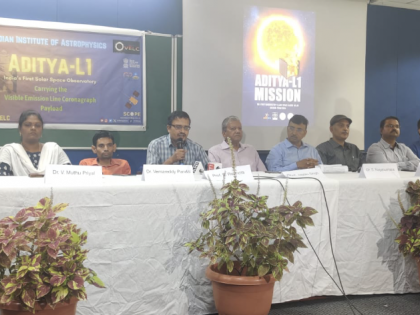Launch of Aditya L-1: "The data that will be sent by the VELC to IIA and eventually to ISRO will become the key observations for creating other significant theories": Professor Jagdev Singh
By Anubha Jain | Published: September 1, 2023 06:20 PM2023-09-01T18:20:00+5:302023-09-01T20:09:16+5:30
“Aditya L-1 will be ISRO’s first India space mission to observe the Sun and the solar corona. Along with ...

Launch of Aditya L-1: "The data that will be sent by the VELC to IIA and eventually to ISRO will become the key observations for creating other significant theories": Professor Jagdev Singh
“Aditya L-1 will be ISRO’s first India space mission to observe the Sun and the solar corona. Along with the six other payloads, the largest and technically most challenging seventh payload on Aditya L-1 is the Visible Emission Line Coronagraph (VELC). It weighs 190 kgs., the heaviest payload in the 240 kgs. of Aditya L1 designed and fabricated by the Indian Institute of Astrophysics (IIA) with substantial support from ISRO.” This was stated by Professor Jagdev Singh, one of the senior scientists of IIA who interacted with Lokmat Times representative Anubha Jain at the IIA campus in Bengaluru today. A few other IIA’s leading scientists and engineers were also present for a press briefing about VELC at the IIA campus in Bengaluru today.It is pertinent to mention that VELC is an internally occulted coronagraph with 40 different optical elements inside it that are aligned precisely. VELC is an instrument that cuts out the light from the disk of the sun and can thus image the much fainter corona at all times. When asked how the mission would be different from other similar projects, Prof. Singh said, “Earlier in 1995 USA launched a satellite in L1 but the data gathered was of a different kind. Here, we will observe the Sun 24 hrs. Aditya L1 will be launched at such a gravitational point where the sun and earth would be neutral. Pictures will be producedevery minute.
However, the most significant one will be filtered and sent back to IIA. A maximum of 1400 pictures will be received in a day. The data that will be given by the VELC to IIA and eventually to ISRO will be the key observations through which other significant theories will be formed. The spacecraft is planned to be placed so close to the sun in a halo orbit around the Lagrangian point 1 (L1) of the Sun-Earth system, which is about 1.5 million km from the Earth. This has the advantage of observing the sun all the time without any blockage. He further said, "The pictures will be received by blending emission lines in plasma and because of this we can accurately predict. Through VELC we will read Solar corona plasma in various weather conditions and temperatures.” Asking about the major challenges of the mission, the head of the Outreach Section and senior scientist at IIA, Bengaluru, Dr. Niruj Mohan Ramanujam informed Anubha Jain that reaching L1 and inserting the satellite into the halo orbit was the biggest challenge. All seven payloads have different requirements and different challenges. So, managing the payloads together and individually is a challenging task. Avoiding molecular contamination, degassing among payloads; temperature adjustments; assembling VELC; and alignments were other complex things.
When Anubha Jain asked about the total duration to reach the L1 orbit, and when the first image is expected, Prof. Jagdev Singh said by the end of February 2024 regular data we are expecting to receive. The other six payloads will be open and start their functioning first and according to that, the VELC, the last yet important payload will open and then start working. He said that it would take 100-plus days to reach. He further said that the data received will be analyzed by the Indian community and after six months or so will be open to other scientists and people across the world.Dr. Niruj Mohan Ramanujam informed that made with four detectors, a 190 mm circular mirror, and other vital parts, VELC is a 90% made-in-India product with 10% of parts being imported from other vendors., The other senior scientists and engineers gave highlight were Dr. Vemareddy Panditi, Prof.B.Ravindra, S.Nagabushana, Amit Kumar, Dr. Sasikumar Raja, Dr.V.Muthu Priyal and S.Kathiravan, and Samriddhi Maity with many research scholars of IIA.